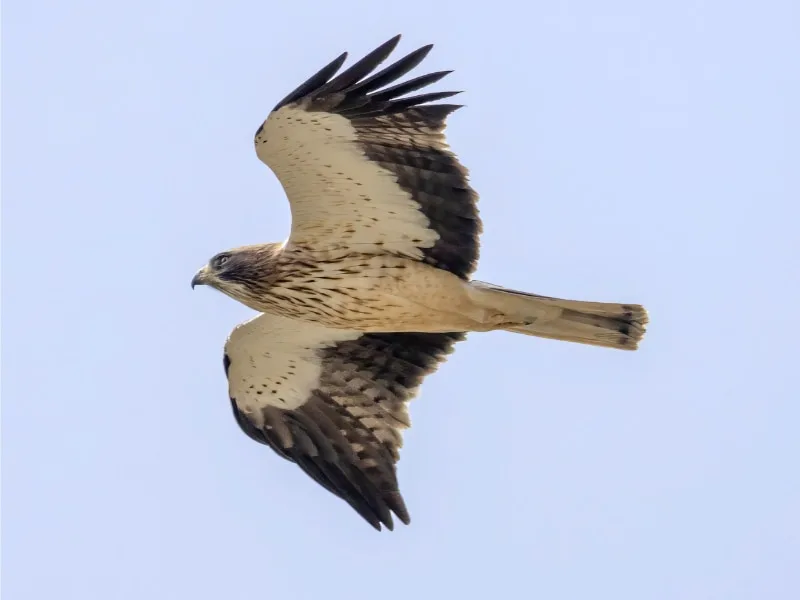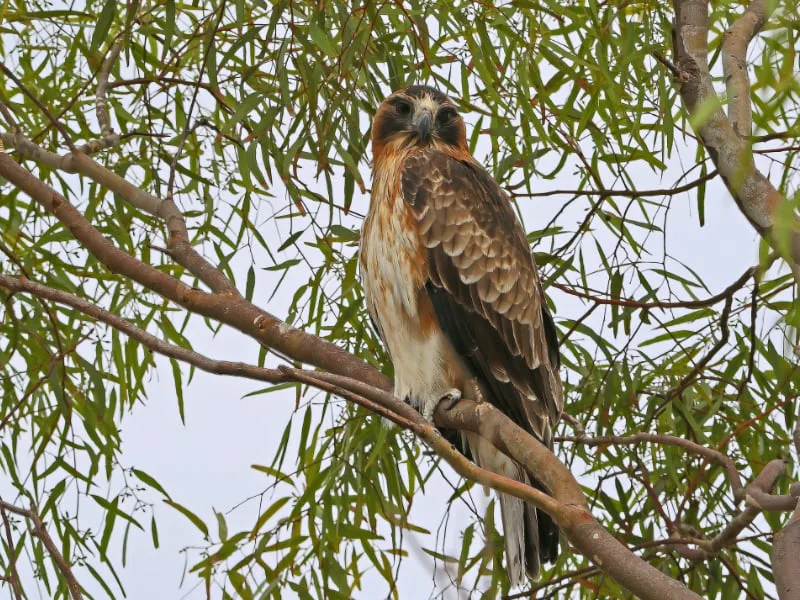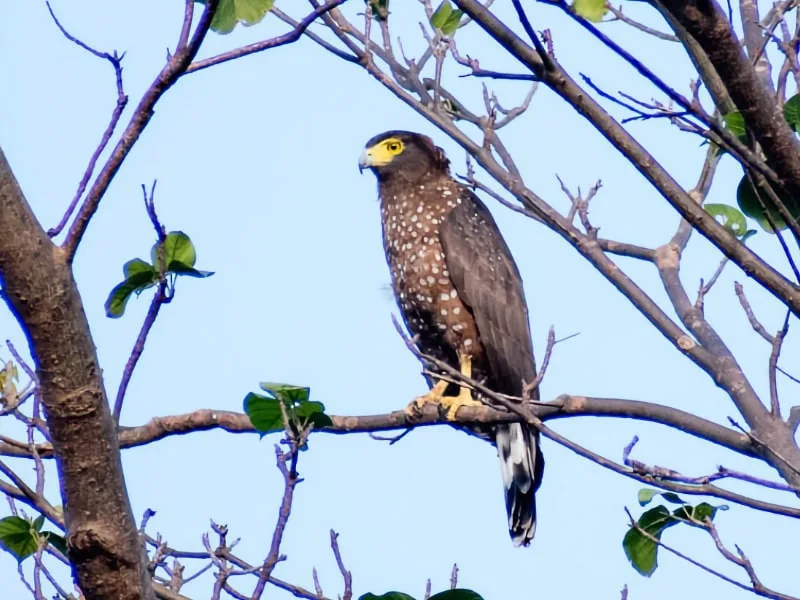The Great Nicobar serpent eagle is the world’s smallest eagle, with adults weighing as little as 450 grams (1 pound) and averaging just 90 centimeters (35.4 inches) in wingspan. Close behind is the pygmy eagle of New Guinea, the smallest member of the Aquilinae subfamily, with some males weighing under 500 grams (1.1 pounds).
This article explores the smallest eagle species known to science, focusing on their verified size in the wild. We look at how these compact hunters survive in forested and open habitats, the evolutionary pressures that shaped them, and the growing threats many of them face from habitat loss and human disturbance.
Great Nicobar serpent eagle (Spilornis klossi)
- Wingspan: About 90 cm (35.4 in).
- Weight: Around 450 g (1 lb).
- Where found: Dense tropical forests of Great Nicobar Island, India.
- Conservation status: Endangered.

The Great Nicobar serpent eagle is likely the smallest eagle in the world, with adult individuals weighing around 450 grams (1 pound), an average wingspan of about 90 centimeters (35.4 inches), and a body length of around 40 centimeters (15.7 inches). With a compact build, short rounded wings, and broad tail, it is well adapted for maneuvering through the dense tropical forests it inhabits. Its dark plumage, barred underparts, and piercing yellow eyes give it a distinctive appearance, but it is rarely seen in the wild due to its elusive behavior and limited distribution.
Endemic to Great Nicobar Island in the Indian Ocean, this eagle is restricted to mature tropical forest habitats and is considered one of the rarest eagles in the world. Population estimates range from 150 to 370 mature individuals, but recent density models suggest that the true number may be closer to 200 adult birds. The species faces severe threats from deforestation, infrastructure development, and competition with more adaptable raptors such as the crested serpent eagle (Spilornis cheela). Conservation action remains minimal despite its endangered status, and with such a restricted range and ongoing habitat loss, the long-term future of the Great Nicobar serpent eagle is precarious.
Pygmy eagle (Hieraaetus weiskei)
- Wingspan: 112-126 cm (44-50 in).
- Weight: 406-555 g (0.89-1.22 lb).
- Where found: Open forests, woodlands, savannas, and rainforest edges across New Guinea (Indonesia and Papua New Guinea).
- Conservation status: Least Concern.

The pygmy eagle is one of the smallest living eagles, rivaled only by the Great Nicobar serpent eagle in body size. Adults typically measure 38 to 48 centimeters (15 to 19 inches) in length, with an average wingspan ranging from 112 to 126 centimeters (44 to 50 inches). Females are slightly larger than males, and estimated weights range from around 406 grams (0.89 pounds) for males to 555 grams (1.22 pounds) for females. With a slim build and agile flight, it is sometimes mistaken for a small hawk or falcon rather than a member of the Aquilinae subfamily, making it the smallest “true eagle” currently known.
This species is native to the island of New Guinea, where it inhabits a broad range of environments – from open woodland and scrub to rainforest edges and highland savannas, from sea level up to elevations of 1,950 meters (6,400 feet). Although its population has not been precisely quantified, the pygmy eagle is relatively widespread across its range and currently faces no major threats that would elevate its conservation status. Its population is believed to be declining slowly, but not at a rate considered concerning.
Booted eagle (Hieraaetus pennatus)
- Wingspan: 110-132 cm (43-52 in).
- Weight: 510-1,025 g (1.12-2.26 lb).
- Where found: Open woodlands and forested landscapes across southern Europe, North Africa, central Asia, and parts of South Africa and India.
- Conservation status: Least Concern.

The booted eagle is a compact, buzzard-sized raptor with the proportions and flight style of a true eagle. Adults average around 40 centimeters (16 inches) in length, with wingspans between 110 and 132 centimeters (43 to 52 inches). Males are significantly lighter than females, with body masses ranging from 510 to 770 grams (1.12 to 1.70 pounds), while females may reach up to 1,025 grams (2.26 pounds). The species is best recognized by its feathered “booted” legs, which give it its name, and by two main color morphs: pale and dark. Its slender build and agile flight allow it to hunt small birds and mammals in open terrain and along forest edges.
The booted eagle occupies a vast range across Europe, Asia, and Africa, breeding in forest patches interspersed with open areas, and wintering in southern Africa and southern Asia. It is generally solitary or found in pairs, even during migration. The booted eagle is highly adaptable and can nest at elevations up to 3,000 meters (9,850 feet). While its global population appears stable, localized declines have occurred due to habitat degradation, deforestation, and persecution. Threats include illegal shooting, poisoning, electrocution on powerlines, and pesticide exposure in wintering grounds.
Little eagle (Hieraaetus morphnoides)
- Wingspan: About 120 cm (47 in).
- Weight: Around 815 g (1.8 lb).
- Where found: Open forests, woodlands, scrublands, and savannas across mainland Australia.
- Conservation status: Least Concern.

The little eagle is a light-bodied, falcon-sized raptor. Adults typically measure 45 to 55 centimeters (17 to 21.5 inches) in length and average around 815 grams (1.8 pounds) in weight, though males are nearly half the weight of females. It has fully feathered legs, a square-cut barred tail, and relatively long wings in proportion to its body. In flight, it alternates between strong wingbeats and extended glides, often soaring on flat or slightly raised wings. Despite its modest size, it is a capable hunter of birds, reptiles, and small mammals.
Endemic to Australia, the little eagle occurs throughout a wide range of habitats including open woodland, dry forest, savanna, and scrub, from sea level up to 1,500 meters (5,000 feet). Though often solitary or in pairs, it is more easily observed than some of its close relatives due to its broad distribution. The global population is thought to be stable, and with no significant threats currently driving population declines at the national or global level, the little eagle remains one of Australia’s most widespread and successful raptors.
Philippine serpent eagle (Spilornis holospilus)
- Wingspan: 105-120 cm (41-47 in).
- Weight: 603-1,600 g (1.3-3.5 lb).
- Where found: Forested lowlands, second-growth, and hilly woodlands across the Philippine archipelago.
- Conservation status: Least Concern.

The Philippine serpent eagle is a medium-small forest raptor with short, broad wings and a bold, crested profile. Adults measure 47 to 53 centimeters (18.5 to 21 inches) in length and show significant size dimorphism, with males weighing 603-672 grams (1.3–1.5 pounds), but females can reach up to 1.6 kilograms (3.5 pounds). It has dark brown upperparts, lighter underparts with barring, and striking yellow facial skin and eyes. Frequently heard before it is seen, the species gives a loud, rising whistle during flight. Soaring individuals are easily recognized by their rounded wings and slow, buoyant circling above forested ridges or clearings.
This species is widely distributed across the Philippine archipelago, occurring in a variety of wooded habitats including lowland rainforest, second-growth, forest edges, and lightly wooded agricultural landscapes. It tolerates a moderate degree of habitat disturbance, though it shows some dependence on forest cover. Deforestation across its range has led to an estimated 10% decline in forest cover over the past three generations, and a corresponding tentative population decline of up to 19% is suspected. However, given its large range and adaptability, the species is not currently considered at risk.
Why these eagles matter
Though they lack the massive wingspans and commanding presence of their larger relatives, the world’s smallest eagles are no less remarkable. Adapted for life in dense forests, rugged landscapes, or patchy woodland, these compact raptors reflect the diversity and adaptability of the eagle lineage. Some remain common and widespread, while others, like the Great Nicobar serpent eagle, are among the rarest birds alive today. Their small size often makes them elusive, but it also underscores how much we still have to learn about these finely tuned aerial hunters. Protecting their habitats ensures that even the smallest of eagles can continue to soar.
Further reading
